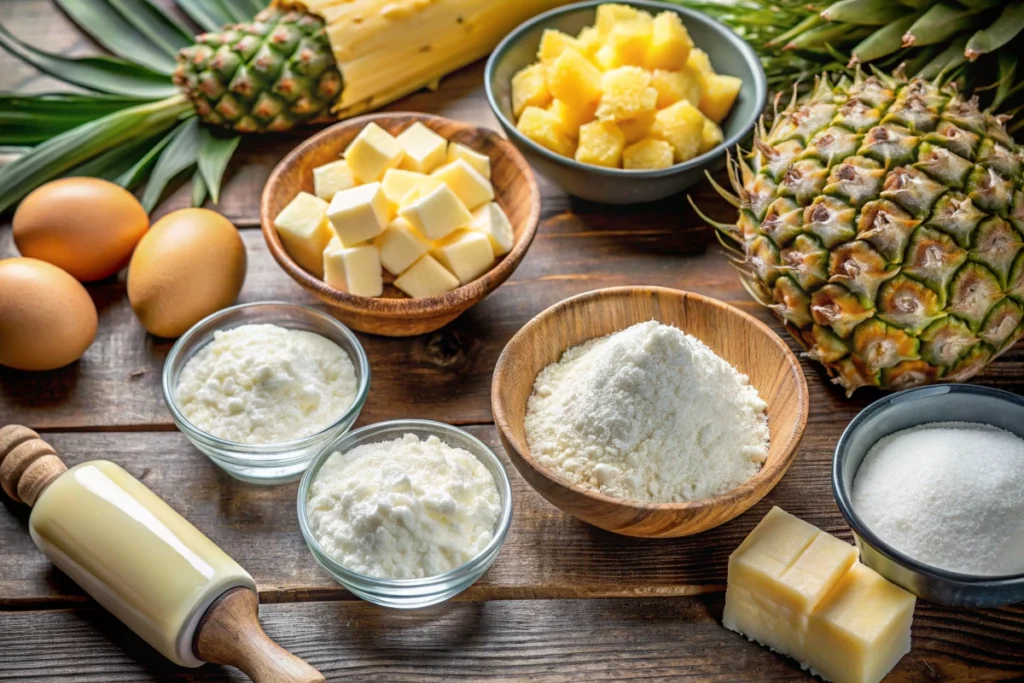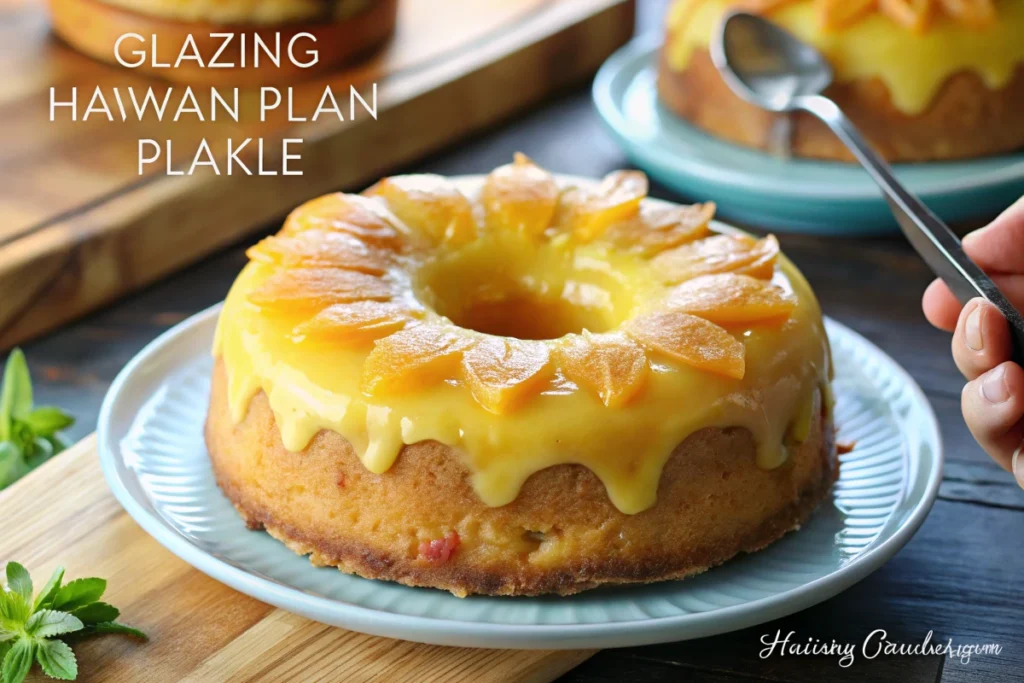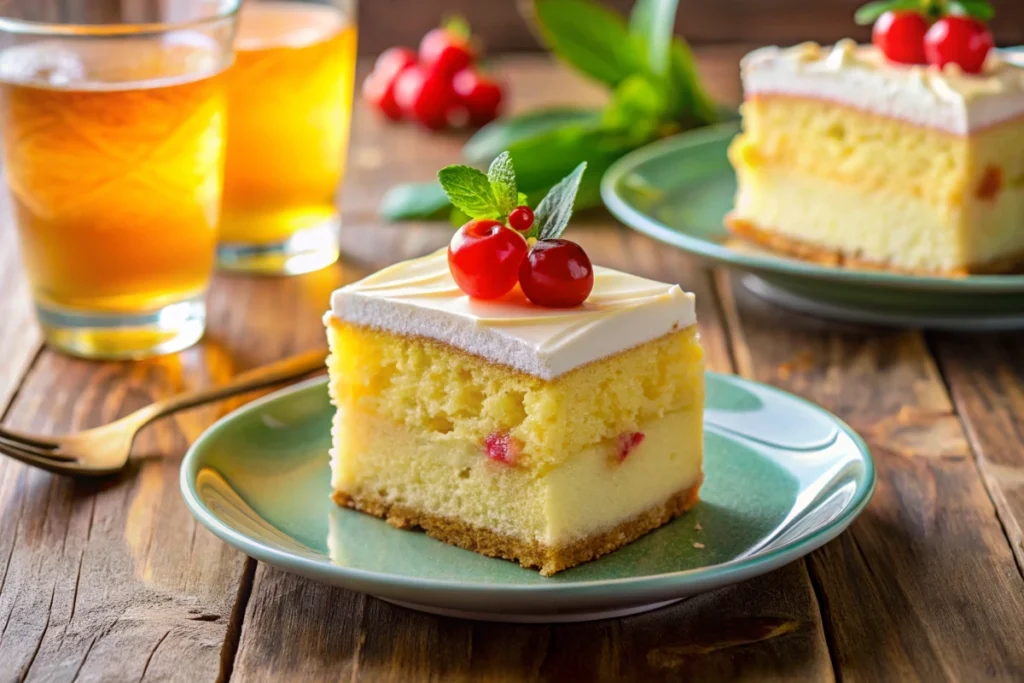Hawaiian pineapple cake is a classic dessert that brings a burst of tropical flavor to your table. Loved for its sweet, tangy taste and moist texture, this cake has become a staple for gatherings, celebrations, or simply indulging in a slice of paradise. In this article, we’ll explore its history, symbolism, and a foolproof recipe to make it at home. Whether you’re a seasoned baker or a newbie in the kitchen, this guide will help you create a Hawaiian pineapple cake that everyone will adore.
Introduction to Hawaiian Pineapple Cake
A Tropical Dessert with Cultural Roots
Hawaiian pineapple cake is more than just a dessert; it’s a symbol of the islands’ welcoming spirit. Pineapples, often regarded as the “king of fruits,” hold special significance in Hawaiian culture. Known for their unique sweetness and vibrant color, they represent hospitality and warmth.
This dessert blends the natural flavors of pineapple with a soft, fluffy cake base, topped with a luscious glaze that accentuates its tropical taste. It’s no wonder that Hawaiian pineapple cake has become a favorite at luaus, family gatherings, and even as an everyday treat.
Why Pineapple is a Hawaiian Symbol
Pineapples were first introduced to Hawaii in the early 1900s, quickly becoming one of the islands’ major exports. Over time, they gained a reputation as a symbol of hospitality, often used in decorations and recipes to welcome guests. Pineapple cakes embody this cultural connection, making them a delightful way to share the Aloha spirit.
Discover great ideas like Crinkle Cake
The History of Hawaiian Pineapple Cake
Origins of Pineapple in Hawaiian Cuisine
The story of pineapples in Hawaii begins in the early 1900s when James Dole established the Hawaiian Pineapple Company. Pineapples were cultivated extensively, and Hawaii quickly became synonymous with this tropical fruit. As pineapples grew in popularity, they found their way into countless Hawaiian recipes, from refreshing beverages to savory dishes and, of course, desserts.
Hawaiian pineapple cake emerged as a creative way to highlight the fruit’s natural sweetness. The recipe adapted over time, incorporating local ingredients and influences from Hawaiian culture, making it a symbol of celebration and joy.
The Rise of Pineapple Cake as a Cultural Staple
Pineapple cake became a favorite at Hawaiian luaus and gatherings, loved for its rich flavor and simplicity. Its versatility allowed for variations, such as pineapple upside-down cake, coconut-infused versions, and even gluten-free options.
What sets Hawaiian pineapple cake apart is its use of real pineapple chunks or crushed pineapple, which adds a distinct tropical flair. It’s not just a cake; it’s a slice of Hawaii’s culinary history, passed down through generations and loved by locals and visitors alike.
The Symbolism Behind Pineapple Cake
What Does the Pineapple Cake Symbolize?
Pineapple cakes symbolize more than just indulgence. In Hawaiian culture, they represent warmth, hospitality, and the welcoming nature of the islands. Offering pineapple-based desserts to guests is a gesture of respect and generosity, echoing the Aloha spirit.
In modern times, pineapple cakes are often served at weddings, birthdays, and cultural events as a way of honoring tradition while bringing people together.
Pineapple as a Symbol of Hospitality
The pineapple’s association with hospitality dates back centuries, with the fruit often displayed as a centerpiece to welcome guests. Its inclusion in cakes and desserts amplifies this message, offering a sweet reminder of Hawaii’s inviting culture.
Ingredients for the Perfect Hawaiian Pineapple Cake
Essential Ingredients for Authentic Flavor
Creating an authentic Hawaiian pineapple cake starts with selecting the freshest ingredients. Each component plays a vital role in achieving the cake’s signature flavor and moist texture. Here’s what you’ll need:
- Crushed Pineapple: Use canned or freshly crushed pineapple, including the juice, to keep the cake moist and flavorful.
- Flour: All-purpose flour works best for a fluffy and tender cake.
- Sugar: Regular granulated sugar balances the tanginess of the pineapple.
- Eggs: Eggs provide structure and richness to the cake.
- Butter: Use unsalted butter for a creamy flavor.
- Baking Powder and Baking Soda: These leavening agents ensure a light and airy texture.
- Vanilla Extract: Adds a subtle sweetness to enhance the tropical flavors.
- Optional Add-ins: Shredded coconut or chopped macadamia nuts can elevate the cake with additional texture and Hawaiian flair.
Substitutions: Can I Use Pineapple Juice Instead of Water?
Yes, you can substitute pineapple juice for water in the recipe. In fact, this is a fantastic way to amplify the pineapple flavor. If you’re using a boxed cake mix, replacing the water with pineapple juice will make the cake more flavorful and moist.
However, keep in mind that pineapple juice is naturally sweet, so you may want to reduce the sugar slightly to balance the sweetness.
Tips for Choosing the Best Pineapple
- Fresh vs. Canned: While fresh pineapple offers a more robust flavor, canned pineapple is more convenient and just as tasty.
- Juice Matters: Always include the juice from the crushed pineapple for maximum moisture.
Step-by-Step Recipe for Hawaiian Pineapple Cake
This easy-to-follow recipe will guide you in creating the perfect Hawaiian pineapple cake, combining the sweetness of pineapples with a moist, fluffy texture. Let’s get started!
Ingredients
Here’s what you’ll need to make a standard 9×13-inch cake:
- 2 cups all-purpose flour
- 1 1/2 cups granulated sugar
- 1 teaspoon baking soda
- 1/2 teaspoon baking powder
- 1/4 teaspoon salt
- 2 large eggs
- 1 teaspoon vanilla extract
- 1/2 cup unsalted butter, melted
- 1 (20-ounce) can crushed pineapple (with juice)
- Optional: 1/2 cup shredded coconut or chopped macadamia nuts for added texture.
Instructions
Step 1: Preheat the Oven
- Preheat your oven to 350°F (175°C).
- Grease a 9×13-inch baking pan and set it aside.
Step 2: Mix the Dry Ingredients
- In a large bowl, whisk together the flour, sugar, baking soda, baking powder, and salt.
Step 3: Combine Wet Ingredients
- In a separate bowl, beat the eggs, then stir in the vanilla extract, melted butter, and crushed pineapple (including the juice). Mix until well combined.
Step 4: Combine Wet and Dry Mixtures
- Gradually add the wet ingredients to the dry ingredients, stirring until just combined. Be careful not to overmix, as this can affect the cake’s texture.
Step 5: Add Optional Ingredients
- If using shredded coconut or macadamia nuts, fold them into the batter.
Step 6: Bake the Cake
- Pour the batter into the prepared pan.
- Bake for 30-35 minutes, or until a toothpick inserted into the center comes out clean.
Step 7: Cool and Glaze
- Let the cake cool completely in the pan before adding the glaze.
Pineapple Glaze Recipe
Ingredients:
- 1/2 cup powdered sugar
- 2 tablespoons pineapple juice
Instructions:
- Mix the powdered sugar and pineapple juice until smooth. Drizzle over the cooled cake.

Is Pineapple Cake a Sativa? Clearing the Confusion
If you’ve come across the term “pineapple cake” in contexts outside of baking, you might wonder if it refers to something entirely different, such as a strain of cannabis. Let’s clear up the confusion.
Debunking the Myth: Pineapple Cake and Cannabis
Pineapple cake, as a dessert, has no connection to cannabis. It is a delicious tropical cake made with crushed pineapple, flour, sugar, and other common baking ingredients.
The confusion arises because some cannabis strains are named after fruits or desserts to describe their flavor or aroma profiles. One such strain is Pineapple Cake, a hybrid cannabis strain known for its fruity aroma and calming effects. However, it is entirely unrelated to the culinary treat we’re discussing.
The Connection Between Pineapple Cake and Pineapple Kush
The names of cannabis strains like Pineapple Cake and Pineapple Kush often originate from their tropical, pineapple-like flavor notes. While these strains may appeal to enthusiasts of fruit-inspired aromas, they have no culinary use or connection to baking.
So, when someone mentions pineapple cake, they’re likely referring to the dessert—unless they’re talking about cannabis in a specific context. Always check the context to avoid misunderstandings!

Variations of Hawaiian Pineapple Cake
Hawaiian pineapple cake is a versatile dessert that can be customized to suit different tastes and dietary preferences. Below are some popular variations to inspire your next baking adventure.
Pineapple Upside-Down Cake
This classic variation is a showstopper! Instead of mixing the pineapple into the batter, slices of pineapple are arranged at the bottom of the pan along with brown sugar and butter. Once baked, the cake is flipped over to reveal a caramelized, glossy pineapple topping.
How to Make It:
- Arrange pineapple rings (and maraschino cherries for extra color) on a layer of melted butter and brown sugar in the baking pan.
- Pour the cake batter over the fruit.
- Bake and invert the cake onto a serving platter for a stunning presentation.
Coconut Pineapple Cake
For those who love a tropical twist, adding shredded coconut to the batter or sprinkling it on top of the glaze enhances the island vibes.
Pro Tip: Toast the coconut for a nuttier flavor and a slightly crunchy texture.
Gluten-Free Hawaiian Pineapple Cake
Whether for dietary needs or personal preference, this cake can easily be made gluten-free by using a 1:1 gluten-free flour blend. Ensure all other ingredients, such as baking powder, are also gluten-free.
Vegan Pineapple Cake
Replace the eggs with flaxseed meal or applesauce, and use plant-based butter or coconut oil instead of dairy butter. Choose a non-dairy glaze option like coconut milk mixed with powdered sugar for a vegan-friendly dessert.
Explore More Gluten-Free Dessert Ideas for a variety of options.
The Language of Pineapple – What is Pineapple in Hawaiian?
Pineapples are deeply tied to Hawaiian culture, not just as an agricultural product but also as a symbol of hospitality and warmth. The Hawaiian language reflects this connection beautifully.
Translation and Cultural Importance
In Hawaiian, pineapple is called “hala kahiki.” The term translates directly to “foreign hala,” as the fruit resembled the native hala plant but was introduced from elsewhere. Despite its non-native origins, the pineapple quickly became a significant part of Hawaiian agriculture and culture, earning a reputation as one of the islands’ iconic symbols.
Hala kahiki has been immortalized in the Hawaiian identity, appearing in songs, art, and, of course, local recipes like Hawaiian pineapple cake.
Fun Hawaiian Phrases for Dessert Lovers
If you’re looking to embrace more of the Hawaiian spirit while serving your cake, here are a few phrases to add to the experience:
- “E ‘ai kakou!” – Let’s eat!
- “Ono loa!” – Very delicious!
- “Mahalo!” – Thank you!
Learning a few Hawaiian words can enhance your appreciation of the culture and add a personal touch to your culinary creations.

FAQs About Hawaiian Pineapple Cake
Many questions arise about the origins, ingredients, and preparation of Hawaiian pineapple cake. Let’s address some of the most commonly asked questions to clear any doubts.
What Does the Pineapple Cake Symbolize?
Pineapple cake symbolizes hospitality and the welcoming spirit of Hawaiian culture. The pineapple itself is a global symbol of warmth and friendship, making it a perfect ingredient for celebrations and gatherings. Offering pineapple cake to guests is a sweet way of sharing the Aloha spirit.
Can I Use Pineapple Juice Instead of Water in a Cake Mix?
Yes, you can! Replacing water with pineapple juice is a great way to enhance the flavor of a cake mix. Pineapple juice adds natural sweetness and tanginess while keeping the cake moist. This substitution works particularly well for box cake mixes if you want to infuse a tropical flair effortlessly.
Is Pineapple Cake a Sativa?
No, Hawaiian pineapple cake is a dessert and is unrelated to cannabis. However, some cannabis strains have names like “Pineapple Cake” or “Pineapple Kush,” which can lead to confusion. These strains are named for their fruity aromas and flavors but have no connection to the edible dessert.
What Is Pineapple in Hawaiian?
In Hawaiian, pineapple is called “hala kahiki”. This term refers to the fruit’s foreign origins and its resemblance to the native hala plant. Despite being introduced to Hawaii, pineapples are now closely associated with Hawaiian culture and cuisine.
How Do I Keep My Pineapple Cake Moist?
To maintain moisture in your pineapple cake, use crushed pineapple with its juice and avoid overbaking. Adding sour cream or yogurt to the batter can also help retain moisture. Storing the cake in an airtight container prevents it from drying out.
Can I Make Pineapple Cake Gluten-Free?
Yes, you can make pineapple cake gluten-free by substituting all-purpose flour with a 1:1 gluten-free flour blend. Make sure all other ingredients, like baking powder, are certified gluten-free.
Conclusion
Hawaiian pineapple cake is not just a dessert—it’s a delightful slice of tropical tradition that brings the Aloha spirit to your table. With its roots deeply embedded in Hawaiian culture, pineapple cake symbolizes warmth, hospitality, and the joy of sharing. Whether you opt for the classic version, try a coconut twist, or experiment with gluten-free or vegan variations, this cake is sure to impress. Its moist texture, rich pineapple flavor, and cultural significance make it a perfect treat for any occasion. So, the next time you’re looking to indulge or celebrate, let Hawaiian pineapple cake be the star of your gathering, offering a taste of paradise with every bite.

Leave a Reply
You must be logged in to post a comment.